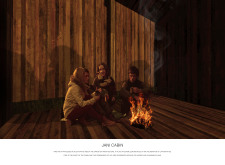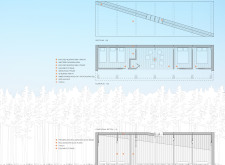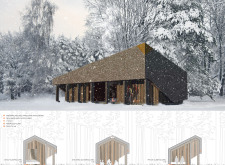5 key facts about this project
The primary concept behind the Jani Cabin revolves around the communal experience. Central to this idea is a spacious gathering area designed to accommodate groups for social interaction and storytelling, reinforcing the significance of fire as a cultural focal point in many traditions, including Latvian. With this, the project invites occupants to come together, sharing not only physical space but also experiences and memories, thereby celebrating community bonds.
Functionally, the Jani Cabin is designed to cater to varied needs. The layout includes designated sleeping areas that offer privacy and comfort, ensuring a restful environment for visitors. Additionally, the integration of equipment storage and dress rooms reflects thoughtful consideration for practical use, positioning the cabin as both a recreational haven and a functional retreat for communal activities. This adaptability speaks to modern user expectations, emphasizing the importance of multi-functional spaces in contemporary architectural design.
The architectural details of the Jani Cabin showcase a careful selection of materials that speak to its cultural narrative and environmental responsibility. Prefabricated reclaimed barn wood beams form the structural backbone of the cabin, celebrating local building traditions and minimizing waste. Similarly, the use of reclaimed barn wood planks adds to the woodsy aesthetic while ensuring the project respects sustainable construction practices. The thatched roof not only provides effective insulation but also ties the design back to traditional methods used in Latvian rural architecture. Complementing these materials, large frameless glass openings allow for ample natural light and create a seamless transition between interior spaces and the surrounding landscape, inviting the outside in and enhancing the overall user experience.
Unique design approaches are evident throughout the Jani Cabin, from its spatial organization to its aesthetic choices. The design harmonizes traditional architectural elements with contemporary needs, capturing a sense of timelessness that resonates with occupants. This balance is particularly noteworthy in the way the communal area is intentionally positioned at the heart of the design, symbolizing the importance of shared experiences in fostering connection and community.
Moreover, the choice of materials reflects a deep respect for the environment. By prioritizing reclaimed resources, the Jani Cabin not only reduces its ecological footprint but also gives new life to historical materials, enriching the narrative of the structure. Such decisions in architectural design exemplify how modern architecture can engage with its environment and cultural context while addressing contemporary issues surrounding sustainability.
In summary, the Jani Cabin stands as a significant project that embodies a thoughtful approach to architecture, blending community, culture, and sustainability in its design. Through its innovative use of materials and emphasis on multi-functional spaces, it invites visitors to engage with their surroundings and each other in meaningful ways. For those interested in exploring this project further, reviewing detailed architectural plans, sections, and design ideas will provide deeper insights into the realized vision and functionality of the Jani Cabin.


























